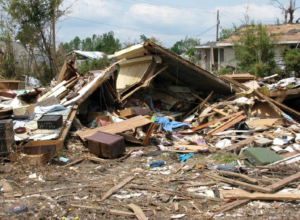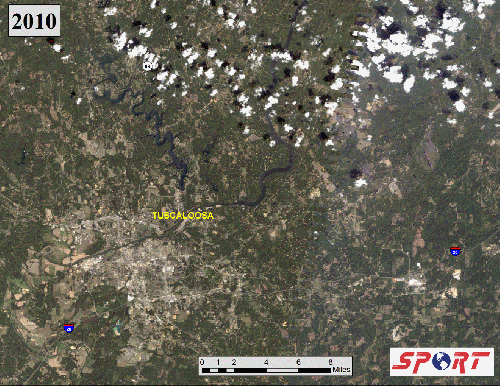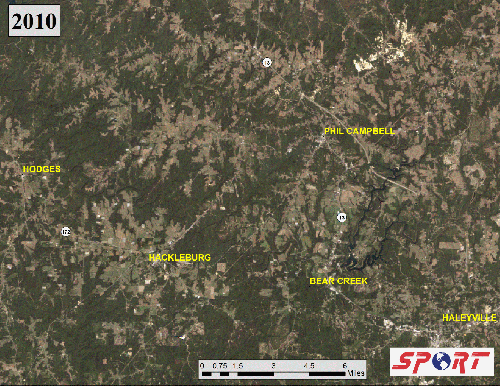
Follow-on studies examined the capability of various NASA sensors for detecting and measuring the length and width of scars visible when using the Normalized Difference Vegetation Index, or NDVI, a measurement of vegetation greenness and health commonly derived from multiple satellite imaging platforms. SPoRT examined NDVI products from MODIS (250 m), Landsat-7 Enhanced Thematic Mapper Plus (ETM+, 30m) and ASTER (15 m) collected in May and June 2011. Possible tornado tracks were identified, mapped, and were then measured to compare against the official NWS damage surveys. In general, many of the major tornadoes (defined here with maximum intensity EF-3 and greater) were at least partially visible at resolutions of 15-250 m, though weaker tornadoes or those that occurred in complex terrain were more difficult to detect using NDVI and a single snapshot in time. As tornadoes initiated and increased in intensity, or dissipated and decreased in intensity, some of their characteristics became more difficult to detect. However, some weaker tornadoes were also apparent in Landsat-7 imagery (30 m) in well-vegetated areas. A summary of the study is available as a publication in the National Weather Association’s Journal of Operational Meteorology. In 2013, SPoRT received support from NASA’s Applied Sciences: Disasters program to partner with the NWS and facilitate the delivery of satellite imagery to their Damage Assessment Toolkit (DAT). The DAT is used by the NWS to obtain storm survey information while in the field. Satellite imagery from NASA, NOAA, and commercial sensors (acquired in collaboration with USGS and the Hazards Data Distribution System) helps to supplement the survey process by providing an additional perspective of suspected damage areas.
Many of the damage scars apparent from the April 27, 2011 outbreak exhibited signs of recovery and change in the years following the outbreak. Other tornado events also brought additional vegetation damage and scarring to the region. With five years passing since the 27 April 2011 tornado outbreak, annual views of cloud-free imagery have been obtained from the Landsat missions, operated and managed as a collaboration between the USGS and NASA. In the viewer linked below, SPoRT has collaborated with the USGS Earth Resources Observation Systems (EROS) Data Center to acquire 30 m true color and vegetation index information from Landsat 5, Landsat 7, and Landsat 8 during the late spring and summer months when local vegetation is at its greenest, allowing the greatest contrast between damaged and undamaged areas. Users can take a look at these images in a web viewer that allows toggling between different products and years, view some of the tornado tracks surveyed by the NWS following the April 27, 2011 event, and zoom into areas of interest to examine how some of the affected areas have evolved over time:








